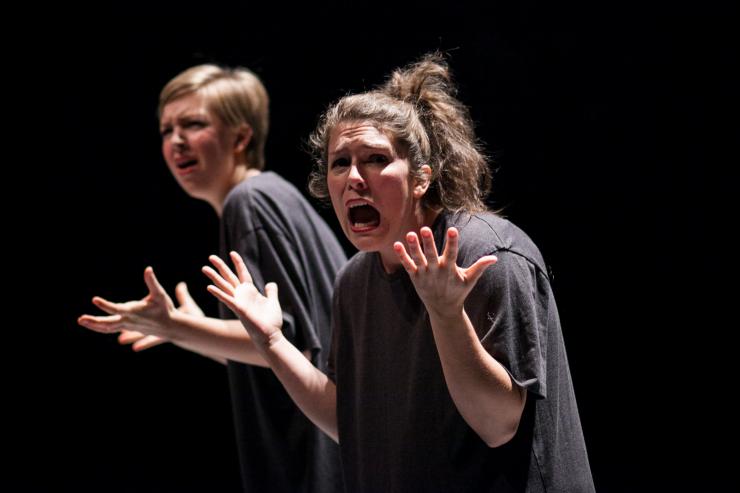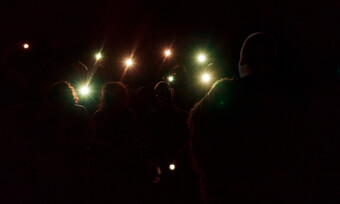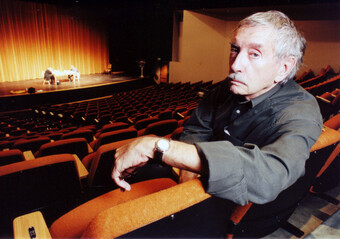Engaging Research
Capturing the Spirit of Critical Inquiry
This is the second of three posts about The Cohen New Works Festival, the largest collegiate festival of new work in the nation, hosted by The University of Texas at Austin. Two students will outline the development and foundation of the festival, capture happenings during the week, and discuss what the American theatre can expect as a result.
When the Cohen New Works Festival was officially underway, the excitement in the air was electric. The theatre and dance facilities at The University of Texas at Austin transformed to host the largest collegiate festival of student new works in the nation for five jam-packed days of theatre, dance, and installation. Hundreds of students stood in line for shows, introduced themselves to guest artists, and shared their new work for the first time. By 8:00 pm on Monday, over 1,000 tickets had been redeemed. Picture entering a brain large enough to host four people (Eye See…Eye Forget), or crawling into a blanket fort led by a nine-year-old actress (Shrines), or a teenage girl texting as the projections above her display the screen of her phone in real time (Teen Girl FANtasies). Each project in the festival is crafted around what we refer to as “the spirit of critical inquiry.” But what on earth does that really mean? The Engaging Research Committee, which works specifically on the festival, has spent the last year developing a structure of what that could look like. This committee creates programming that reflects on the multiple ways we engage with research, and fosters new practices of engagement that promote collaboration and critical inquiry.

The spirit of critical inquiry is shaped around specificity, context, and exploration. Specificity means knowing what the project is and what it seeks to do; its critical framework. The articulation of specificity begins with the application process—which this year saw a record-setting seventy-two—and continues when a handful of projects are paired with students from a New Works Dramaturgy course. The syllabus of this class is closely tied to the festival. The dramaturgical support created between the Engaging Research committee and this course allows projects to fully explore the vision through comprehensive research during the entire semester leading up to the festival. The committee pairs projects that are interested with a dramaturg, and provides research support by helping to make connections with campus resources, and conducting workshops on how to lead a talkback after a show. Support created around projects changes every cycle to suit the needs of the projects in the festival, acting as a model for responsive education in our department.
Since every project is able to interact with this level of professionalism and support, we are able to see glimpses of the possible life the pieces have beyond the festival. By connecting research, community engagement, and working with professional guest respondents, students are able to more fully see their work as a necessary part of the field.
Creating context is associated with locating the project in the lineage of other work. In addition to connecting with on and off-campus resources, every project is paired with a professional guest artist based on the content and type of work of each piece. In the installation Eye See… Eye Forget, those involved in the project did extensive research on Alzheimer's disease, including interviewing a patient—who would later become the model for their brain—and her family. The patient’s grandson is a student in the UT Austin Theatre and Dance department. This type of collaboration greatly expanded the definition of an on and off-campus resource. After the opening night of my project, Emanation, I was able to sit with Nadine Mozon, an actor, poet, dramatist, and teacher at Texas State University, and receive immediate feedback. The combination of her professional prowess and fresh eyes witnessing the play was essential to exploring the intention of my piece even further. Since every project is able to interact with this level of professionalism and support, we are able to see glimpses of the possible life the pieces have beyond the festival. By connecting research, community engagement, and working with professional guest respondents, students are able to more fully see their work as a necessary part of the field.
Exploration, as defined by the Cohen New Works Festival, is creating space to venture into other directions, seeking out opportunities and resources that are brand new to the creators. For example, Welcome Home is an interactive dance, movement, and theatrical event that resulted from the collective experiences of four dancers after visiting Angers, France. I witnessed live dancing enclosed in an intimate room of couches, armchairs, and knickknacks, softly lit like someone's living room. Video and photos from their trip were projected onto a small screen during the dancing at times, underscored by strange, disorienting music; it was powerful and moving, to say the least. As for Mad & A Goat, the performances are specifically unique to the festival; they served as a way to present the culmination of two years of various workshops the piece went through. The multimedia used in Teen Girl FANtasies made me rethink how theatre and the ever-prominent internet can be intertwined with theatrical storytelling. What are the untold stories among people that live in the cloud? These modes of exploration are powerful; not only do they express a unique perspective of research and specificity, they present possibility. I am inspired not only as an audience member witnessing such a variety of theatre and artistry, but as a theatremaker to see work that engages artists and incites change, all through exploration.

The way we engage with research shifts every year to meet the needs of projects in the festival, but these three components—specificity, context, and exploration—remain a reflection of the dedication to embodying the spirit of critical inquiry in ways that are comprehensive and have long-term impacts on artists. As I continue to soak up the passion, integrity, and fearlessness that is the 2015 Cohen New Works Festival, my peers are recharging me as they present their new works in progress. Artistic warriors surround me. It is humbling, it is electric, it is a call to action for audiences and artists alike to take risks, to ask questions, and to venture into the unknown without fear.











Comments
The article is just the start of the conversation—we want to know what you think about this subject, too! HowlRound is a space for knowledge-sharing, and we welcome spirited, thoughtful, and on-topic dialogue. Find our full comments policy here